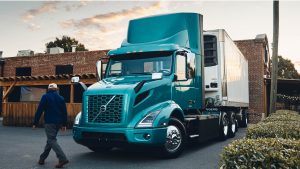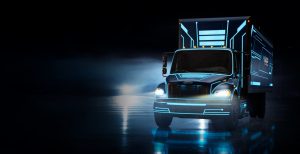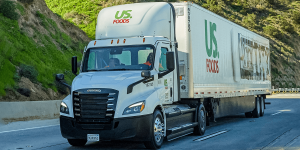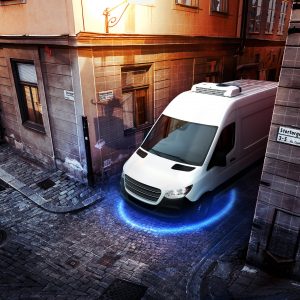- Discover the Future of Freight: Dive into the California Diesel Ban, setting a 2042 deadline for zero-emissions trucks in the trucking industry. How will this ambitious move, powered by innovative electric technology, reshape the landscape of sustainable transportation initiatives?
- Unveiling $26.5 Billion in Health Benefits: Explore how California’s Advanced Clean Fleets rule, leveraging cutting-edge electric vehicle (EV) technology, is poised to revolutionize public health and air quality, addressing diesel pollution health impacts. What does this mean for the future of environmental policy in California?
- Overcoming Industry Hurdles: Unpack the challenges and solutions surrounding the transition to electric heavy-duty vehicles. From electric vehicle infrastructure to innovation, how is California leading the charge with advanced electric tech?

California’s Diesel Ban is a bold stride towards sustainability, yet it’s the collective effort and adaptability of the industry that will define its success.
In an unprecedented move, the California Diesel Ban sets a global benchmark in environmental policy, mandating a complete shift to zero-emissions for all new diesel big rigs by 2036. This ambitious initiative underscores California’s dedication to combating climate change and heralds a new era of significant public health improvements by curbing diesel pollution, all while embracing the remarkable benefits of electric vehicle technology. Yet, it’s crucial to approach this transition with a balanced perspective, recognizing the substantial hurdles that lie ahead in achieving zero-emissions transportation.
California Diesel Ban Leads with Advanced Clean Fleets Rule
The Journey to Zero-Emissions
CARB’s leadership steers California towards a diesel free future, setting a flag with the Diesel Ban.
The California Air Resources Board (CARB) has taken a monumental step with the unanimous approval of the Advanced Clean Fleets rule, a cornerstone of California’s sustainable transportation initiatives. This pioneering regulation mandates that all new commercial trucks, including garbage trucks, delivery trucks, and other medium and heavy-duty vehicles, transition to electric power. This move is part of California’s broader commitment to achieving 100-percent renewable energy by 2045 and follows the state’s ban on new gasoline-powered cars starting in 2035. It represents a significant leap forward in adopting innovative electric technologies that promise to transform the transportation sector.
Unveiling Health and Environmental Benefits
The rule is poised to deliver an estimated $26.5 billion in public health benefits, significantly improving air quality and addressing diesel pollution health impacts. Heavy-duty trucks, while only constituting 10 percent of vehicles on U.S. roads, are responsible for a substantial portion of nitrogen oxide and fine particle pollution, making this initiative a critical step towards cleaner air. The shift to electric vehicles (EVs) brings notable real-world advantages, such as drastically reduced emissions, lower operating costs, and decreased noise pollution, contributing to a healthier and more sustainable environment.
“This landmark decision marks a pivotal moment in our fight against climate change,” said a CARB spokesperson. “The Advanced Clean Fleets rule is not just about reducing emissions; it’s about harnessing the power of electric technology to create a healthier future for all Californians.”
Enjoying our insights?
Subscribe to our newsletter to keep up with the latest industry trends and developments.
Stay Informed
However, the path to achieving these ambitious goals is not without its challenges. Industry experts and stakeholders highlight the need for significant advancements in electric vehicle infrastructure, technology, and policy to fully realize the potential of electric heavy-duty vehicles.
Addressing Industry Concerns and Infrastructure Challenges

Charging ahead: Building the infrastructure for tomorrow’s electric truck fleets.
Despite the environmental and health benefits, the transition faces opposition from truck manufacturers and industry groups, citing the high costs of electric models and the current inadequacy of electric vehicle charging infrastructure. The industry also voices concerns over the ambitious timelines, especially given the logistical challenges at ports. However, the rapid advancement in electric vehicle technology, including improvements in battery life, charging speed, and overall vehicle efficiency, is quickly addressing these concerns, making electric trucks more viable and cost-effective for widespread adoption.
“To truly succeed in this transition, we must address the concerns head-on, ensuring that the infrastructure and economic frameworks are in place to support this monumental shift,” stated a representative from a leading truck manufacturing company. This sentiment is echoed by fleet operators who are on the frontline of adopting these new technologies. “The potential for cost savings and environmental benefits is clear, but we need more support in terms of infrastructure and incentives to make the switch feasible,” shared a fleet operator.
Environmental advocates also weigh in on the discussion, emphasizing the importance of steadfast commitment and innovation to overcome these barriers. “While the challenges are significant, the benefits of a zero-emissions future cannot be overstated. It’s imperative that all stakeholders work together to address these issues,” remarked an environmental advocate.
Detailed Timelines for a Greener Future
- 2035 Deadline for Drayage Trucks: A significant milestone requiring these trucks to adopt electric models, with a mandate for zero-emissions in new sales starting in 2024. This shift not only signifies a move towards cleaner air but also showcases the practical benefits of electric technology in reducing operational costs and maintenance for fleet operators.
- 2042 Zero-Emissions Target: A comprehensive requirement for all trucks, including specialized vehicles like garbage trucks and school buses, to achieve zero-emissions, with larger fleets leading the transition. The adoption of electric vehicles in these sectors highlights the versatility and efficiency of electric technology across various applications.
Environmental advocates also weigh in on the discussion, emphasizing the importance of steadfast commitment and innovation to overcome these barriers. “While the challenges are significant, the benefits of a zero-emissions future cannot be overstated. It’s imperative that all stakeholders work together to address these issues,” remarked an environmental advocate. Stay updated on the latest trends in emissions reduction across the trucking industry, check out this link.
Navigating the Transition: Overcoming Electric Truck Challenges

Achieving 100% renewable energy by 2045 is a bold vision that demands unprecedented collaboration and technological advancement.
Now we will delve into the multifaceted challenges and strategies for transitioning to electric heavy-duty vehicles, highlighting the collaborative efforts required to build the infrastructure of tomorrow, drive technological innovations, and implement economic incentives that support this transition in line with the California Diesel Ban.
Building the Infrastructure for Tomorrow
Expanding Charging Networks
One of the most pressing concerns in adhering to the California Diesel Ban is the current lack of a comprehensive charging infrastructure capable of supporting the unique needs of heavy-duty electric trucks. Efforts are underway to establish a network of high-capacity charging stations that can accommodate the extended range requirements and larger battery capacities of HDVs. This includes initiatives to deploy chargers along key freight corridors and at strategic locations such as warehouses and truck depots, ensuring that electric trucks can operate efficiently on both regional and long-haul routes, thereby supporting California’s renewable energy goals. For additional insights into the development of charging stations, explore this page.
Public-Private Partnerships

While electric vehicles promise a sustainable future, the transition demands careful navigation of economic and logistical hurdles.
The development of a robust EV charging infrastructure, crucial for the success of the California Diesel Ban, requires significant investment and coordination. Public-private partnerships are emerging as a vital mechanism for pooling resources and expertise. These collaborations are focused on overcoming technical and logistical hurdles, such as ensuring the availability of high-speed charging and integrating renewable energy sources to power the network, thereby enhancing the sustainability of electric truck operations.
Technological Innovations and Economic Incentives
Advancements in Battery Technology
Rapid advancements in battery technology are addressing key concerns related to range anxiety and charging times, crucial for the adoption of zero-emissions trucks as mandated by the California Diesel Ban. Innovations in battery chemistry and design are increasing energy density, which extends the driving range of electric trucks and reduces the frequency of charging stops required. Additionally, improvements in charging technology are making it possible to recharge large batteries more quickly, minimizing downtime for vehicles.
Hydrogen Fuel Cells: An Alternative Path

Partnerships between public and private sectors emerge as a cornerstone for overcoming the infrastructure challenges of tomorrow’s electric fleets.
Beyond battery electric vehicles, hydrogen fuel cell technology offers another pathway to zero-emissions for heavy-duty transportation, aligning with the goals of the California Diesel Ban. Fuel cell electric vehicles (FCEVs) are particularly suited for long-haul trucking, where their longer range and faster refueling times compared to battery EVs could provide a competitive advantage. Investments in hydrogen infrastructure, including fueling stations and green hydrogen production, are crucial to realizing the potential of FCEVs in the trucking sector.
Financial Mechanisms to Support Transition
The economic viability of electric trucks, a key concern in meeting the California Diesel Ban, is a critical concern for fleet operators. To address this, a combination of federal and state incentives, such as tax credits, grants, and rebates, are being implemented to reduce the upfront cost of electric vehicles and charging infrastructure. These financial incentives, along with the decreasing total cost of ownership for electric trucks as technology progresses, are making the transition more economically feasible for businesses. Understand the strategies being employed to manage operational costs in the industry, explore this link.
Collaborative Efforts for a Seamless Transition
Stakeholder Engagement

The transition to electric heavy-duty vehicles offers a alternative, yet underscores the need for continued innovation in energy storage and charging technologies.
Successfully navigating the transition to electric heavy-duty vehicles, in compliance with the California Diesel Ban, requires the active involvement of all stakeholders, including government agencies, vehicle manufacturers, energy providers, and fleet operators. Through forums, coalitions, and working groups, these stakeholders are sharing knowledge, aligning on standards, and coordinating efforts to address the multifaceted challenges of electrifying the trucking industry.
Policy Support and Regulatory Frameworks
Effective policies and regulatory frameworks are essential to support the transition to electric trucks, a critical component of the California Diesel Ban. This includes regulations that encourage the adoption of zero-emission vehicles, policies that facilitate the development of charging infrastructure, and standards that ensure the interoperability of charging equipment. By providing a clear and supportive regulatory environment, policymakers can help accelerate the shift towards a cleaner, more sustainable trucking industry.
In conclusion, while the path to electrifying California’s heavy-duty truck fleet is complex, the concerted efforts of stakeholders, coupled with technological innovations and supportive policies, are laying the groundwork for a successful transition. By addressing infrastructure challenges, leveraging economic incentives, and fostering collaboration, California is leading the way towards a zero-emissions future in heavy-duty transportation, in line with the ambitious goals set by the California Diesel Ban.
Explore More on Sustainable Transportation
- Battery Electric Vehicles and Technology: Explore our news on advancements in battery technology and its role in powering zero-emissions trucks, visit this link.
- Hydrogen Fuel Cells as an Alternative to Battery Electric: For insights into how hydrogen fuel cells are contributing to the zero-emissions future, check out this page.
- Sustainability and Renewable Energy Initiatives: Discover more about the push towards sustainability and renewable energy in transportation, explore this page.
- Partnerships and Collaborations in the Industry: Learn about the public-private partnerships driving forward the infrastructure and technology needed for trucks, follow this link.
Further Insights on Zero-Emissions Transportation
- California Air Resources Board (CARB) – Advanced Clean Trucks Regulation: Gain an in-depth understanding of the regulation and its implications for the trucking industry.
- U.S. Department of Energy – Alternative Fuels Data Center: Explore comprehensive resources on electric vehicles, charging infrastructure, and alternative fuels.
- Environmental Protection Agency (EPA) – Green Vehicle Guide: Learn about the environmental impact of various vehicle types, including heavy-duty electric trucks.
- International Council on Clean Transportation (ICCT) – Zero-Emission Trucks: Discover global trends, policies, and strategies for accelerating the adoption of zero-emission trucks.
- Electric Power Research Institute (EPRI) – Electric Transportation: Access research and reports on electric transportation, infrastructure development, and technology advancements.
- National Renewable Energy Laboratory (NREL) – Transportation Research: Delve into studies and analyses on sustainable transportation solutions, including electric trucks and infrastructure.




















